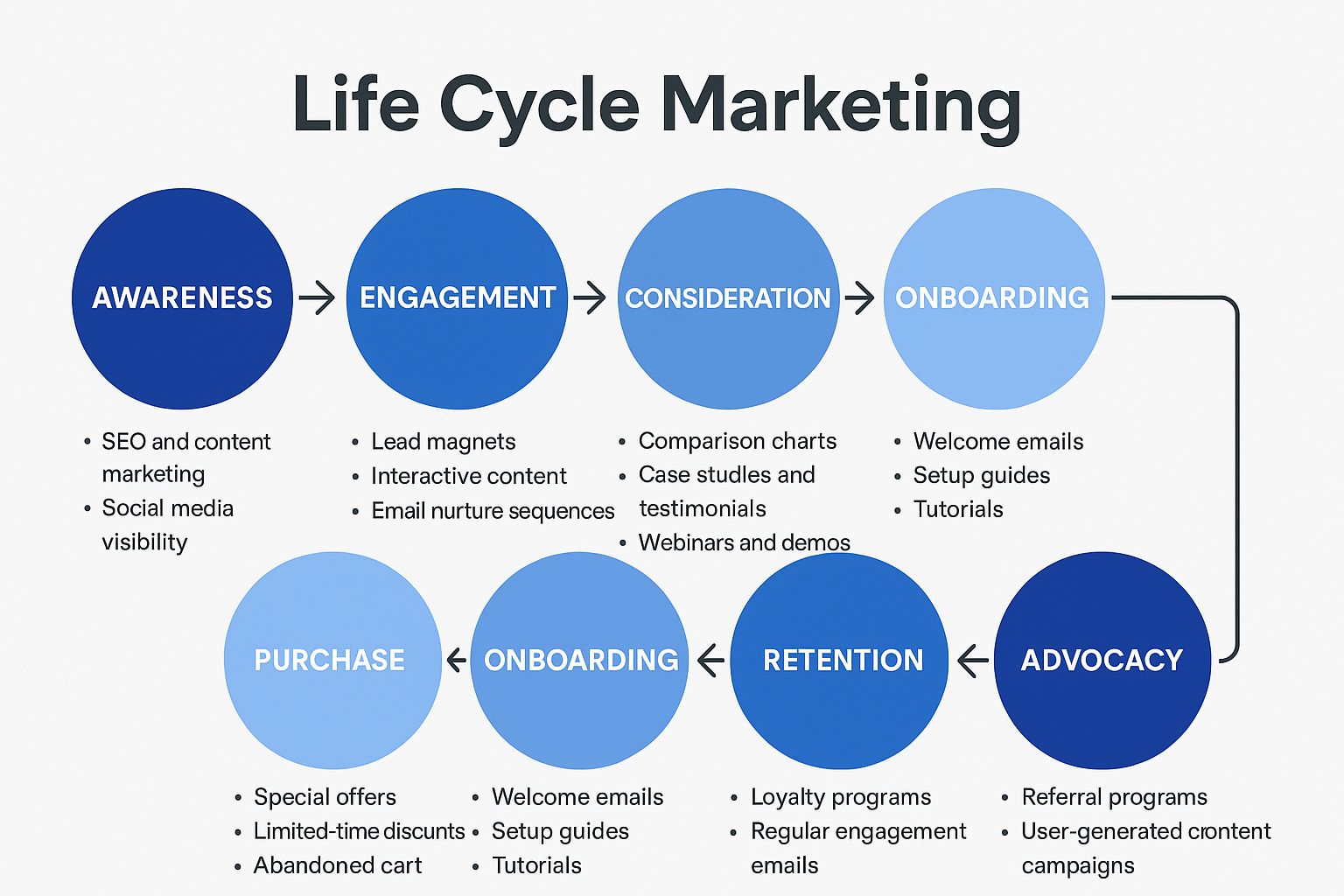The Ultimate Guide to Life Cycle Marketing: How to Win Customers for Life

In a world where customer attention is harder to capture and easier to lose, Life Cycle Marketing has become the secret weapon of brands that build loyal followings and skyrocket their revenue.
Instead of thinking of marketing as a one-time transaction — "run ad → make sale" — life cycle marketing treats each customer like a relationship, nurturing them at every stage of their journey. The goal? Maximize lifetime value, loyalty, and advocacy.
Let’s dive deep into what Life Cycle Marketing is, why it matters, and how you can implement it starting today.
What Is Life Cycle Marketing?
Life Cycle Marketing is a strategy that aligns your marketing activities to the different stages a customer goes through — from first hearing about you to becoming a loyal brand advocate.
It focuses on:
- Attracting new leads
- Engaging them with valuable experiences
- Converting them into paying customers
- Delighting them after the sale
- Encouraging loyalty and repeat purchases
Think of it like dating: You don’t propose on the first date — you build trust, show you care, and make your partner feel valued over time.
Why Life Cycle Marketing Matters
- Higher Customer Lifetime Value (CLV): It’s cheaper to keep a customer than to acquire a new one.
- Better Customer Experiences: Personalized interactions at each stage create strong emotional bonds.
- More Referrals: Happy customers turn into your best marketers.
- Increased Profitability: Loyal customers spend more and churn less.
In short, life cycle marketing turns your customer base into your biggest competitive advantage.
The 7 Stages of Life Cycle Marketing (And What to Do at Each)
Here’s a simple framework you can apply:
1. Awareness
Goal: Make potential customers aware you exist.
Tactics:
- SEO and Content Marketing
- Paid ads (Google, Facebook, etc.)
- Social media visibility
- Influencer partnerships
- PR and media coverage
Tip: Focus on solving problems your target audience already has.
2. Engagement
Goal: Build interest and trust.
Tactics:
- Lead magnets (ebooks, checklists, free trials)
- Interactive content (quizzes, polls)
- Email nurture sequences
- Retargeting ads
Tip: Capture emails early — it gives you direct access for future nurturing.
3. Consideration
Goal: Help customers evaluate your solution.
Tactics:
- Comparison charts
- Case studies and testimonials
- Webinars and demos
- Personal consultations
Tip: Anticipate and answer objections before they arise.
4. Purchase
Goal: Make buying easy and frictionless.
Tactics:
- Special offers and limited-time discounts
- Clear, fast checkout processes
- Flexible payment options
- Abandoned cart recovery emails
Tip: Reduce uncertainty — offer guarantees or easy returns.
5. Onboarding
Goal: Help customers quickly realize value.
Tactics:
- Welcome emails
- Setup guides and tutorials
- Personalized check-ins
- Customer support resources
Tip: A great onboarding experience reduces buyer's remorse and refunds.
6. Retention
Goal: Keep customers coming back.
Tactics:
- Loyalty programs
- VIP customer offers
- Regular engagement emails
- Product updates and upgrades
Tip: Surprise and delight customers with unexpected bonuses or thank-you gifts.
7. Advocacy
Goal: Turn loyal customers into brand champions.
Tactics:
- Referral programs
- User-generated content campaigns
- Testimonials and case study features
- Exclusive communities and events
Tip: Make sharing easy — reward advocacy generously.
Tools to Support Life Cycle Marketing
You don’t have to do this manually. Here are some tools that help:
- CRM Systems (like HubSpot, Salesforce): Track customer interactions.
- Email Automation (like ActiveCampaign, Klaviyo): Send targeted messages.
- Analytics Tools (like Google Analytics, Hotjar): Measure engagement.
- Loyalty Platforms (like Smile.io): Reward repeat purchases.
- Survey Tools (like Typeform): Gather customer feedback.
Combine all This tool with RetentionScript
RetentionScript helps you combine each tools and helps you connect and use these tools together.
.png)
Workflow with apps connected and talking to each other with users journey
Life Cycle Marketing Example: How Apple Does It
Apple is a master of life cycle marketing:
- Awareness: Product launch events and massive media coverage
- Engagement: Free workshops, sleek website experience
- Consideration: In-store experiences, Genius Bar consultations
- Purchase: Limited-time deals for students, easy financing options
- Onboarding: Beautiful unboxing experience, simple setup
- Retention: Frequent updates and integration across devices
- Advocacy: Loyal fanbase that promotes Apple without being asked
Lesson: Every touchpoint feels intentional and premium. \
Final Thoughts: Start Small, Think Big
Life cycle marketing can sound overwhelming — but you don’t have to master everything overnight.
Start by mapping your customer's journey and improving one stage at a time.
Remember: Customers don’t fall in love with brands because of one good ad. They fall in love because you consistently show up, deliver value, and make them feel understood — at every step of their journey.
And that’s the real magic of life cycle marketing.